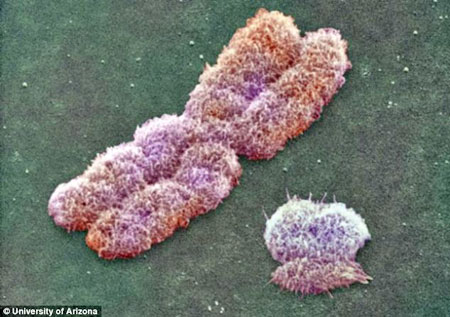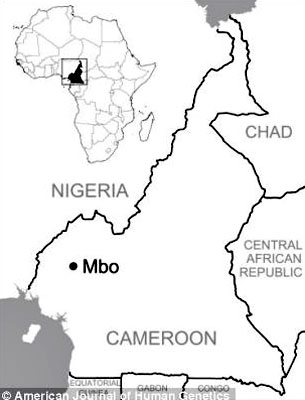|

by Mark Prigg
7 March 2013
from
DailyMail Website
Discovery made after American
submitted his DNA to a family tree service.
DNA traced to
Mbo, a population living in a tiny area of western
Cameroon.
Proves last common Y chromosome ancestor lived 338,000 years ago,
even though oldest fossil of modern man
is only 200,000 years old.
A DNA test on an American hoping to
trace his family tree has come up with a stunning result - the roots
of the human tree date back much further than previously thought.
Researchers were shocked when they analyzed the DNA of Albert
Perry, a recently deceased African-American from South Carolina.
'This lineage diverged from
previously known Y chromosomes about 338,000 years ago, a time
when anatomically modern humans had not yet evolved,' said
Michael Hammer of the University of Arizona.
'This pushes back the time the last
common Y chromosome ancestor lived by almost 70 percent.'

Y me? X chromosome
(left)
and the much smaller
Y chromosome,
which determines male
sex
|
Y IS IT IMPORTANT?
Unlike the other human
chromosomes, the majority of the
Y chromosome does not
exchange genetic material with other chromosomes, which
makes it simpler to trace ancestral relationships among
contemporary lineages.
If two Y chromosomes carry the same mutation, it is
because they share a common paternal ancestor at some
point in the past.
The more mutations that differ between two Y chromosomes
the farther back in time the common ancestor lived.
|
This time predates the age of the oldest
known anatomically modern human fossils.
The fossil record dates back about 200,000 years, said Michael
Hammer.
Either interbreeding with
Neanderthals or other populations
led to the unusual genetic makeup, he said, or humans evolved far
earlier than the extant fossil record suggests.
The new divergent lineage - which was found when Mr Perry contacted
Family Tree DNA, a company
specializing in DNA analysis to trace family roots - branched from
the Y chromosome tree before the first appearance of anatomically
modern humans in the fossil record.
Unlike the other human chromosomes, the majority of the Y chromosome
does not exchange genetic material with other chromosomes, which
makes it simpler to trace ancestral relationships among contemporary
lineages.
If two Y chromosomes carry the same mutation, it is because they
share a common paternal ancestor at some point in the past. The more
mutations that differ between two Y chromosomes the farther back in
time the common ancestor lived.
The results are published in the
American Journal of Human Genetics (An
African American Paternal Lineage Adds an Extremely Ancient Root to
the Human Y Chromosome Phylogenetic Tree.)
Originally, Mr Perry's DNA sample was submitted to the National
Geographic Genographic Project.
When none of the genetic markers used to assign lineages to known Y
chromosome groupings was found, the DNA sample was sent to Family
Tree DNA for sequencing.
Fernando Mendez, a postdoctoral researcher in Hammer's lab,
led the effort to analyze the DNA sequence, which included more than
240,000 base pairs of the Y chromosome.

The team found a
similar chromosome in the Mbo,
a population living
in a tiny area of
western Cameroon in
sub-Saharan Africa
Hammer said:
'The most striking feature of this
research is that a consumer genetic testing company identified a
lineage that didn't fit anywhere on the existing Y chromosome
tree, even though the tree had been constructed based on perhaps
a half-million individuals or more.
'Nobody expected to find anything like this.'
About 300,000 years ago Neanderthals are
believed to have split from the ancestral human lineage.
It was not until more than 100,000 years later that anatomically
modern humans appear in the fossil record.
They differ from the more archaic forms by a more lightly built
skeleton, a smaller face tucked under a high forehead, the absence
of a cranial ridge and smaller chins.
Hammer said the newly discovered Y chromosome variation is extremely
rare.
Through large database searches, his team eventually was able to
find a similar chromosome in
the Mbo, a population living in a
tiny area of western Cameroon in sub-Saharan Africa.
'This was surprising because
previously the most diverged branches of the Y chromosome were
found in traditional hunter-gatherer populations such as Pygmies
and the
click-speaking KhoeSan, who are
considered to be the most diverged human populations living
today.'
'Instead, the sample matched the Y chromosome DNA of 11 men, who
all came from a very small region of western Cameroon,' Hammer
said.
'And the sequences of those individuals are variable, so it's
not like they all descended from the same grandfather.'
|
WHAT HAPPENED TO THE NEANDERTHALS?

Is this what
killed the Neanderthals?
Researchers
believe an inability to hunt
small animals
like rabbits led to their demise
About 300,000 years ago, Neanderthals are believed to have split
from the ancestral human lineage.
It was not until more than 100,000 years later that anatomically
modern humans appear in the fossil record.
The latest theory claims the humble rabbit helped kill off the
Neanderthals.
Experts have long thought that the demise of the Neanderthal was
down to food.
Now a new theory claims that it was their inability to adapt to
hunting small animals, such as rabbits, that was the final nail in
their coffin, as the population of larger animals hunted for food
dwindled. |
Hammer cautions against popular concepts of 'mitochondrial Eve' or
'Y chromosome Adam' that suggest all of humankind descended from
exactly one pair of humans that lived at a certain point in human
evolution.
'There has been too much emphasis on
this in the past,' he said.
'It is a misconception that the genealogy of a single genetic
region reflects population divergence. Instead, our results
suggest that there are pockets of genetically isolated
communities that together preserve a great deal of human
diversity.'
Still, Hammer said:
'It is likely that other divergent
lineages will be found, whether in Africa or among
African-Americans in the U.S. and that some of these may further
increase the age of the Y chromosome tree.
'There has been a lot of hype with people trying to trace their
Y chromosome to different tribes, but this individual from South
Carolina can say he did it.'
|



